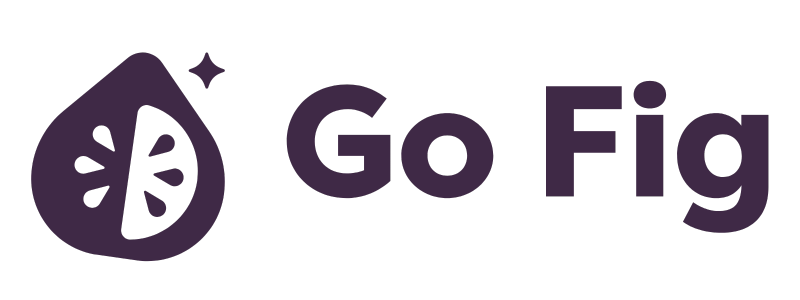Have you ever wondered why you're having a slow day on a Friday night? The weather is great, you just released a fresh batch of a new beer, and you even sent out an Instagram post with tonight's specials, but as you're standing behind the bar you begin to wonder if you should have entered into this expensive hobby in the first place. You day dream about the last time your tap room was a thriving full house and the thousands in sales you made that night made you feel like you made it! You wonder what you did right, and why tonight is so different. Perhaps the answer lies in customer segmentation. If only you could replicate your success so that every Friday night was that night. Picture the satisfied smiles, clinking glasses, and the satisfying hum of conversations blending with the mellow music. Imagine being able to pay yourself a fat paycheck every month, and you could sleep well knowing you could wake up tomorrow and keep brewing. What a dream that would be!
But it doesn't have to stay a dream. We can turn that dream into reality, simply by understanding what components went right on the good day and replicating that success again and again. To do this, we'll lean on analytics to identify your best customers, and find ways to continue to engage and foster customer loyalty through marketing, events and your menu. If this task feels dauting, you may want to read our guide to leverage AI to support you as a business consultant with a one time cost of $1.
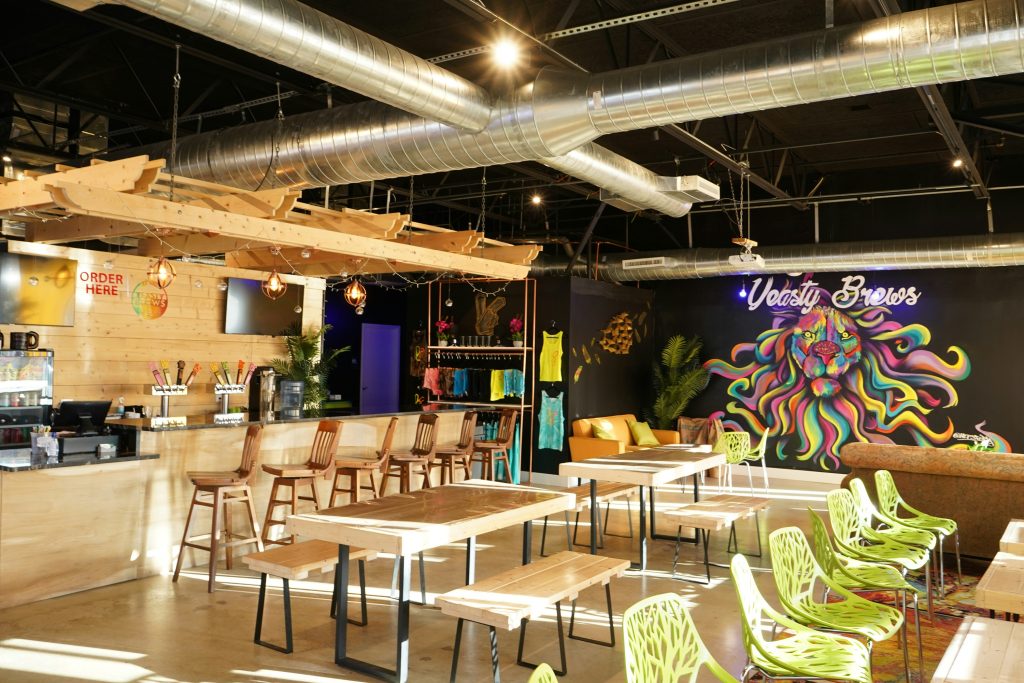
What is Customer Segmentation:
You know your regulars: there's Jim, Dale, and Sean. You know what they like to eat and drink, and you can expect them right to the minute. But what about the rest of your customers? Who's that guy wearing the green hat and skinny jeans? What drew him in to your brewery tonight? Does he love the beer and vibes you offer, so much so that you start seeing him every month? If so, you might begin to wonder if there more versions of that customer around town that don't know about you yet.
A Customer Segmentation Analysis is the process of grouping similar customers together into different groups. Common traits to group customers include geographic, demographic, psychographic, and behavioral traits. Having well defined segments will allow a business owner to research the local market size for each group, plan to brew the beer and update the venue to cater to the primary segments that promise the most lucrative opportunity, and develop a strategy to grow these segments via marketing and events. To help explain this in more detail, let's imagine a fictional brewery named Yeasty Brews. This brewery sits in an urban neighborhood near multiple colleges and universities, office buildings where young professionals work, and popular venues for live music. They serve a variety of craft beers that caters to a broad audience. An example of their customer segments might look like the following:
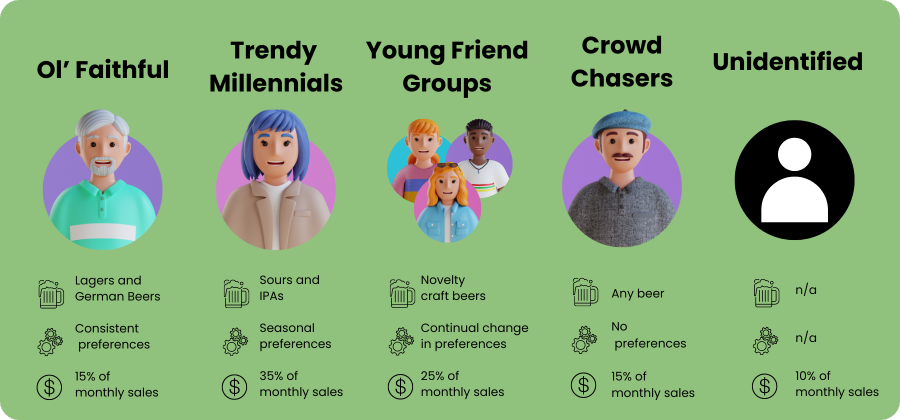
Ol' Faithful
Men above the age of 40 who like to wind down during early happy hour before heading home to the family. They wear professional attire and drink mostly lagers and German beers, usually just one and never more than two. They come consistently, rain or shine, and whether or not you have an event, although they prefer the less busy times without events. This group makes up 15% of monthly sales.
Trendy Millennials
Millennials in the age range between 30-45 who are married with kids. They don't come as frequently, but are consistent nonetheless. They have the highest average ticket of any other segment and when they're in the room, you can feel the party. They respond well to social media posts, are signed up to your loyalty programs (such as Arryved Loyalty), and plan their visit during specials, promotions, and events. They like to order the more trendy beers, which currently might be sours and IPAs, but their preferences change with the season and year, and its a process of constant learning to see what's working now. This group makes up 35% of monthly sales.
Young Friend Groups
Mostly college and recently graduated students in the age range between 21-28 who are single and go out in larger groups. They don't stay long, because they like the appeal and novelty of bar hopping. They make sure the brewery is on their agenda for the evening because they love the new and creative flavors they don't get anywhere else, like the Mocha Stout and Chili Kolsch. This group makes up 15% of monthly sales.
Crowd Chasers
Novelty seeking customers who follow social media and show up for big events where they expect a large showing for the energy and vibes. They like to come when they see a lot of people at the brewery, and they tend to order anything on the menu. While they're nice to have, its incredibly hard to predict when they come and near impossible to directly get them in the door. This group makes up 15% of monthly sales.
Unidentified
We are probably not able to identify every single group of customers, so we'll save a catch-all group for the remaining unidentified customers. Because their interests or tastes are spread out, its hard to know exactly what they like or why they come. We'll continue to do some research on this group as we gather more data. This group makes up 10% of monthly sales.
Time to Get Busy
Once these segments are well defined, a brewery can create an action plan to turn those slow Friday nights into very busy nights. There are four primary levers: menu, space, event calendar, and marketing. Notice that we didn't include pricing as a lever. This is because by focusing on maximizing the experience for a brewery's best-fit customer, a brewery will be able to charge a premium for the craft beers on their menu. Remember that a brewery is a for-profit business, and discounts on craft beer doesn't help to keep the lights on.
Menu
In our example above, the different segments ordered different types of beer and had varying preferences in how frequently their preferences changed. Additionally, we found that total sales were different for each of these groups. As a result, the proportion of beers on your menu should roughly match the proportion of sales of the groups that reveal their preferences. In our example, Ol' Faithful, Trendy Millennials, and Young Friend Groups show a strong preference for categories of beer. For this brewery, we would want to have 20% of the menu to represent lagers and German beers, ~50% of beers to be sours and IPAs, and 30% of the menu to be novelty craft beers.
It is very important to keep track of sales by these segments and beer types on a monthly or even weekly basis. As soon as you notice any meaningful inflection in sales from a particular segment, you need to update your menu accordingly. For example, if you notice fewer sales coming from your loyal trendy millennial group, it could be because the changing of seasons means they're not interested in sours anymore. Maybe they've caught on to a new beer that a neighboring brewery started to offer and are going there instead. Keep close tabs on what these customers are asking for, either through casual conversations, surveys to customers directly via Email, or polls on Instagram on what beer they might want you to make next. Consider making small batches of new beers you see gaining popularity from other breweries posting on Instagram and offer them as a "limited special". If the small batch flies off the shelf, schedule it for your next production batch. If its hard to sell, toss it and try something else!
On the other hand, if you are finding success among Young Friend Groups, consider doubling down on this segment. Increase the proportion of novelty craft beers on your menu. Continually test out new and interestingly weird flavors that piques the interest of this segment. You may find that your entire brewery's business model begins to pivot to this new segment, and that's perfect-- you can continue to foster this niche!
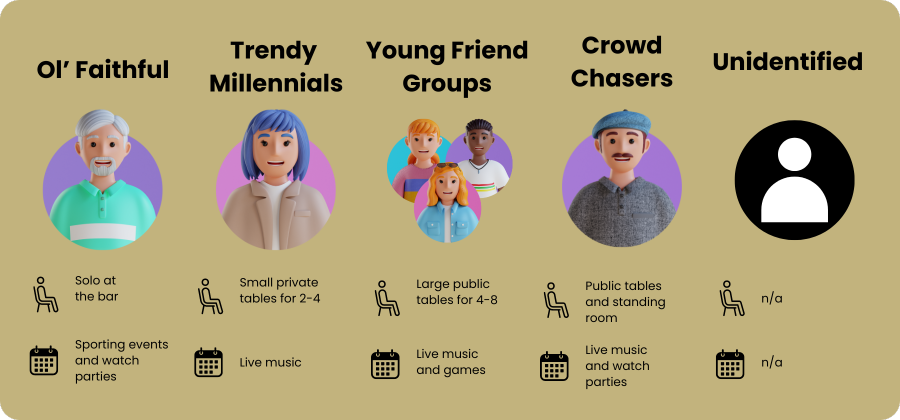
Space
Similar to the menu offering above, we want to make sure that the spaces is creating the vibes that is expected of our customer groups. Taproom space boils down to the bar, small tables, and large tables; TV or no TV; indoor vs outdoor. The primary consideration here is to notice what type of space reaches capacity first. Our example brewery will want to prioritize space for the segments that drive the most sales, which includes smaller private tables for Trendy Millennials and bar seating for Ol' Faithful. That being said, if a large group of friends can't find a spot for their group to sit during a busy time, they may opt to go somewhere else, even if there are two smaller tables available, whereas Millennials can still sit at a large table if the smaller private tables fill up. So when in doubt, get more bigger tables than you think you'll need. But in reality, this may take some trial and error, and constant adjusting with the season and as your business finds growth with a singular customer segment over another.
Event Calendar
Second to your menu, events are the lifeblood of your brewery. Get as creative as you do with beer-- events can include holiday events for every season, synergistic promotions with food trucks and other businesses, live music from bands and DJs, games like trivia and music bingo, and watch parties of local sports teams and other sports. It's a good idea to test out a broad variety of events to start out with. When you do this, keep close tabs on how much sales increases across each customer segment as a result of the event. For example, you might find that watch parties greatly appeal with Ol' Faithfuls and Young Friend Groups, but less with Trendy Millennials. Additionally, you might find that live EDM music tends to attract the Trendy Millennial crowd, and less with the other customer segments. You might be tempted to just keep doing both. But these events aren't always free, so you'll need to calculate what is the incremental profit.
| Event | Cost to Host Event | Actual Sales | Net Return from Event |
| No Event | n/a | $4,000 | n/a |
| March Madness Watch Party | $0 | $4,500 | +$500 |
| Live EDM Music | $500 | $6,000 | +$1,500 |
| Music Bingo | $200 | $5,000 | +$800 |
Let's assume that our example brewery tried out multiple events. They consistently generate $4,000 in sales on a typical Friday night, so they can evaluate how much more Sales were generated by the event alone. In this example, the March Madness watch party generated $500 more than expected, while live EDM music generated $2,000 more than expected. Why is this? It could be because this event appealed to Ol' Faithful and Young Friend Groups, the two segments who were most likely to show up for a beer that night with or without the event. Live EDM music, however, saw a huge increase across the Trendy Millennials. Many of your customers in this segment changed their plans to visit your brewery instead of somewhere else because of the event offering. And even though Live EDM music cost more than a watch party, it still paid off because the net return after accounting for the cost of the event was highest compared to the cheaper events. If you notice a big lift in sales from a particular customer segment like this, keep doing what works. By fostering customer loyalty in a particular segment, you'll begin to grow this segment and increase the frequency of repeat customers as well, a double score!
The last thing to remember is to continue innovating on your event offerings. Remember that preferences get stale, and even your most consistent customers seek novelty from time to time. Keep trying out new events to appeal to your largest customer segments, and track what is getting you new customers and more incremental sales above what you would have expected from a non-event night.
Marketing
Finally, we've saved the best for last! Okay, we know, nobody likes marketing. Well, we do. Marketing is important. It is the engine that keeps your customers engaged when they leave your brewery for the night and keeps them wanting more so they come visit you again the next chance they get. It is the engine that draws in new customers who are similar to your loyal customers but may not yet know how much they will enjoy your beer and venue. Without this engine, it is difficult to maintain month over month sales, and impossible to grow sales year over year.
If you've done marketing before, you will have noticed that it is expensive. Breweries do not have the marketing budget to blast a promotion out to the entire city and get as many people in the door as possible. Even if they did, that would be a bad business decision. You might be paying for ads that draw in people who don't actually like your menu or space, and they will never come back for a repeat visit.
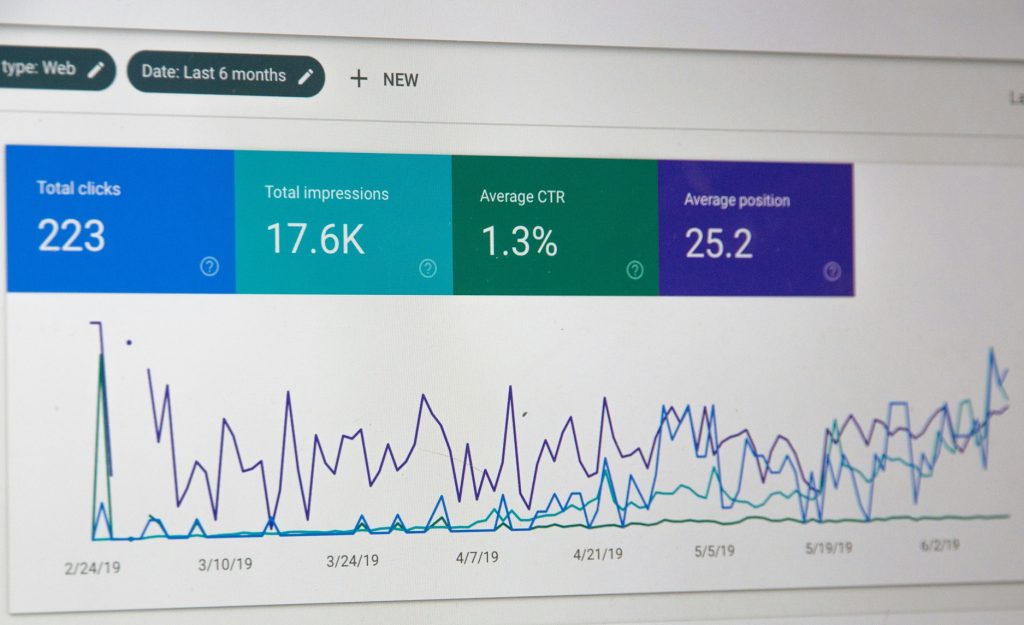
This is where having well defined customer segments is crucial-- with these segments, you will be able to be incredibly specific with marketing to your best-fit customers. When promoting a new beer, for example, you will already know that you need to promote the beer to the customer group that likes that type of beer, i.e. a sour promotion should target Trendy Millennials. Same for events and spaces. Social media platforms allow you to perform "look-alike" marketing, where you can take the email addresses of specific customer segments from your email list or loyalty program and get a sample of customers that have a similar demographic, similar interests, and even have mutual social connections with your existing customers in a particular segment. By doing this for each of your defined segments, you will be able to get the right messaging to the right people, keeping marketing costs down, and marketing effectiveness high.
The ratio of higher sales resulting from marketing to marketing costs is known as marketing efficiency. The higher the marketing efficiency, the more you are getting out of each $1 of marketing spend. Be sure to calculate marketing efficiency by each of the segments you are targeting in your recurring analysis. Again, breweries should constantly be innovating and trying new things with what and how they market, and double down on what works best to increase loyal customers and grow sales consistently.


